Stan C. Smith's Blog, page 17
December 5, 2022
Awesome Animal Fact - Scorpion-eating Meerkats
Did you know meerkats like to eat scorpions? And that they teach their young how to safely kill scorpions? Meerkats, those adorable mammals from southern Africa that like to stand tall on their hind legs, are omnivores, but they really like scorpions.
Hunting scorpions is dangerous business, so meerkat parents teach their young by bringing them scorpions that have been dismembered. When adult meerkats find a scorpion, they dart in, grab it quickly, and rip the stinger from the arachnid's tail. A scorpion's pinchers don't have venom, though they can still be painful, so meerkats usually remove those too.
To teach the very young meerkats, the adults bring them dead scorpions. As the youngsters get more experience, the adults bring them live scorpions with the stinger and pinchers removed. Finally, when the young are mature enough, the adults bring them live intact scorpions.
Even with the stinger removed, some scorpions still have venom in their exoskeletons, so meerkats have even learned to rub their captured scorpions in the sand to remove the remaining venom.
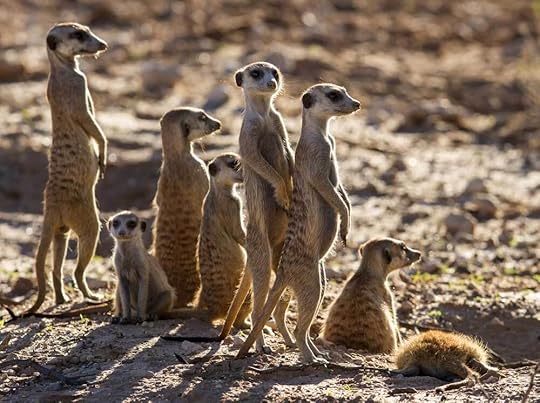
Photo Credits:
- Meerkat family - DepositPhotos
Hunting scorpions is dangerous business, so meerkat parents teach their young by bringing them scorpions that have been dismembered. When adult meerkats find a scorpion, they dart in, grab it quickly, and rip the stinger from the arachnid's tail. A scorpion's pinchers don't have venom, though they can still be painful, so meerkats usually remove those too.
To teach the very young meerkats, the adults bring them dead scorpions. As the youngsters get more experience, the adults bring them live scorpions with the stinger and pinchers removed. Finally, when the young are mature enough, the adults bring them live intact scorpions.
Even with the stinger removed, some scorpions still have venom in their exoskeletons, so meerkats have even learned to rub their captured scorpions in the sand to remove the remaining venom.

Photo Credits:
- Meerkat family - DepositPhotos
Published on December 05, 2022 09:06
December 2, 2022
Awesome Animal Fact - Record Ocean Sunfish
Did you know there is a brand new record for the world's largest bony fish? The new champion is an ocean sunfish.
Keep in mind that sharks and rays are cartilage fish, not bony fish. The whale shark is, by far, the largest fish living today, followed by the basking shark, the great white shark, the tiger shark, and the manta ray. But when it comes to bony fish, the ocean sunfish takes the prize. And as of December 9, 2021, a sunfish was found that beat the previous record (also held by a sunfish).
Unfortunately, the sunfish was found dead, probably from being struck by a passing ship. It had traces of ship paint in a wound on its back. But marine biologists towed the body to shore and used a crane scale to weigh it. The official weight? 6,049 pounds (2,744 kg). Almost a thousand pounds heavier than the previous sunfish record holder.
Astoundingly, when these giant fish are born, the young are only a quarter inch long, the size of a pencil eraser.
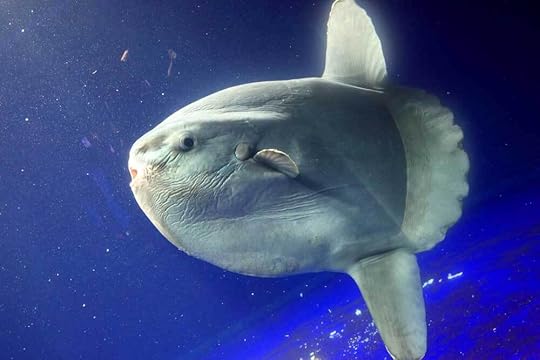
Photo Credits:
- Ocean sunfish - DepositPhotos
Keep in mind that sharks and rays are cartilage fish, not bony fish. The whale shark is, by far, the largest fish living today, followed by the basking shark, the great white shark, the tiger shark, and the manta ray. But when it comes to bony fish, the ocean sunfish takes the prize. And as of December 9, 2021, a sunfish was found that beat the previous record (also held by a sunfish).
Unfortunately, the sunfish was found dead, probably from being struck by a passing ship. It had traces of ship paint in a wound on its back. But marine biologists towed the body to shore and used a crane scale to weigh it. The official weight? 6,049 pounds (2,744 kg). Almost a thousand pounds heavier than the previous sunfish record holder.
Astoundingly, when these giant fish are born, the young are only a quarter inch long, the size of a pencil eraser.

Photo Credits:
- Ocean sunfish - DepositPhotos
Published on December 02, 2022 10:47
November 27, 2022
Awesome Animal Fact - Long-fanged Gaboon Viper
Did you know gaboon vipers have the longest fangs of any venomous snake? Their fangs are two inches (5 cm) long.
In spite of their ominous-sounding name, gaboon vipers, although quite venomous, are considered docile creatures, and they rarely bite humans. Most bites occur when people accidentally step on one of the snakes, or when they try to pick one up. If disturbed, these snakes tend to raise their head and hiss loudly before they resort to biting. Not only that, but gaboon vipers can control how much venom they release when they bite, from no venom to a full load. So, a bite to a human might cause no ill effects at all, or it might be deadly.
Gaboon vipers are extremely thick and heavy for their length. An individual that is six feet long can weigh 45 pounds (20.4 kg).
Gaboon vipers hunt by lying still, well camouflaged, waiting for birds or small mammals to come close enough to strike. Most venomous snakes strike and release their prey, then use their keen sense of smell to track the prey animal to where it has died from the venom. However, gaboon vipers strike and hold on to their prey. Holding on to a mammal that can bite is dangerous business, which is probably why gaboon vipers have fast-acting venom.

Photo Credits:
- Gaboon viper - DepositPhotos
In spite of their ominous-sounding name, gaboon vipers, although quite venomous, are considered docile creatures, and they rarely bite humans. Most bites occur when people accidentally step on one of the snakes, or when they try to pick one up. If disturbed, these snakes tend to raise their head and hiss loudly before they resort to biting. Not only that, but gaboon vipers can control how much venom they release when they bite, from no venom to a full load. So, a bite to a human might cause no ill effects at all, or it might be deadly.
Gaboon vipers are extremely thick and heavy for their length. An individual that is six feet long can weigh 45 pounds (20.4 kg).
Gaboon vipers hunt by lying still, well camouflaged, waiting for birds or small mammals to come close enough to strike. Most venomous snakes strike and release their prey, then use their keen sense of smell to track the prey animal to where it has died from the venom. However, gaboon vipers strike and hold on to their prey. Holding on to a mammal that can bite is dangerous business, which is probably why gaboon vipers have fast-acting venom.

Photo Credits:
- Gaboon viper - DepositPhotos
Published on November 27, 2022 10:46
November 22, 2022
Awesome Animal Fact - Sacred Dung Beetle
Did you know the Egyptian dung beetle (Scarabaeus sacer) was symbolically sacred to the ancient Egyptians? In fact, it is thought the symbol of this beetle was as important to the ancient Egyptians as the cross is to Christians. But why? After all, it's a dung beetle, right?
Well, the dung beetle was considered a symbol of Khepri, the early morning version of the sun god Ra. So, how exactly was that connection made? Dung beetles have a habit of rolling a ball of dung to a suitable location (where they lay their eggs in the dung). Egyptians compared this seemingly endless task of dung beetles to Khepri's task of rolling the sun across the sky.
Not only that, but Egyptians noticed that baby dung beetles eventually emerged from the balls of dung, and they (incorrectly) assumed that the male beetle could make babies without the help of a female, simply by depositing his sperm into the ball of dung. So, they compared this "phenomenon" to the god Atum, who also made babies without any help.
Personally, I consider dung beetles to be fascinating even without their historical "sacredness."
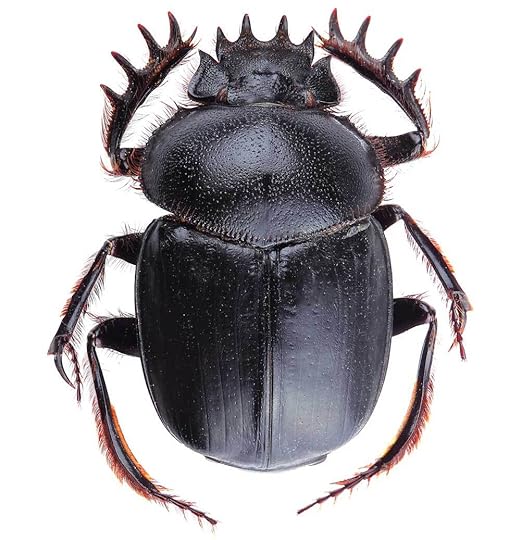
Photo Credits:
- Egyptian dung beetle - DepositPhotos
Well, the dung beetle was considered a symbol of Khepri, the early morning version of the sun god Ra. So, how exactly was that connection made? Dung beetles have a habit of rolling a ball of dung to a suitable location (where they lay their eggs in the dung). Egyptians compared this seemingly endless task of dung beetles to Khepri's task of rolling the sun across the sky.
Not only that, but Egyptians noticed that baby dung beetles eventually emerged from the balls of dung, and they (incorrectly) assumed that the male beetle could make babies without the help of a female, simply by depositing his sperm into the ball of dung. So, they compared this "phenomenon" to the god Atum, who also made babies without any help.
Personally, I consider dung beetles to be fascinating even without their historical "sacredness."

Photo Credits:
- Egyptian dung beetle - DepositPhotos
Published on November 22, 2022 11:34
November 18, 2022
Awesome Animal Fact - Snuffling Sea Pig
Did you know there is a weird type of sea cucumber, called a sea pig, that snuffles around on the bottom of the ocean looking for food? The sea pig (Scotoplanes globosa) lives in really deep areas of the ocean, and it feeds on algae and animals that die and sink to the ocean floor. When a large animal, like a whale, dies and sinks, huge herds of sea pigs gather around it to feed on the decaying matter.
A particularly interesting thing about sea pigs is that, for some reason, they are often seen with a juvenile king crab clinging to them (in the photo below, the juvenile crab is beneath the sea pig, and you can see two of its pink legs grasping the sea pig's body). No one knows for sure why. One hypothesis is that the young crab is protected from predators when near the sea pig, as sea pigs secrete toxic chemicals from their skin. Predators don't like that stuff, but the young king crabs don't seem to care.
So, perhaps sea pigs are crab babysitters.
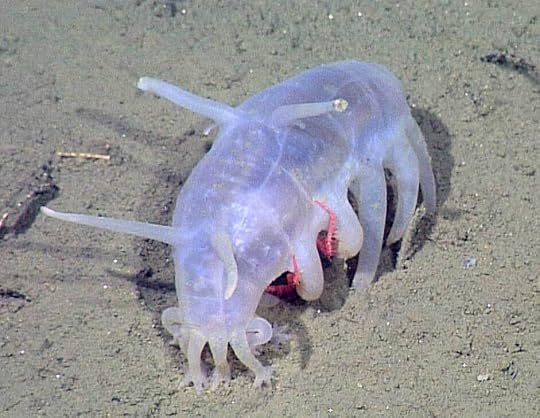
Photo Credits:
- Sea pig - NOAA/MBARI, CC BY-SA 3.0, via Wikimedia Commons
A particularly interesting thing about sea pigs is that, for some reason, they are often seen with a juvenile king crab clinging to them (in the photo below, the juvenile crab is beneath the sea pig, and you can see two of its pink legs grasping the sea pig's body). No one knows for sure why. One hypothesis is that the young crab is protected from predators when near the sea pig, as sea pigs secrete toxic chemicals from their skin. Predators don't like that stuff, but the young king crabs don't seem to care.
So, perhaps sea pigs are crab babysitters.

Photo Credits:
- Sea pig - NOAA/MBARI, CC BY-SA 3.0, via Wikimedia Commons
Published on November 18, 2022 05:54
November 12, 2022
Awesome Animal Fact - Giant Earthworm
Did you know there is an earthworm in Australia that is typically a meter long? The giant Gippsland earthworm lives in the grasslands of Victoria, and some individuals grow to over six feet (2 m) long!
People can actually hear these earthworms moving through the soil beneath their feet, and it sounds like water draining from a bathtub. As I'm sure you can guess, this is the largest earthworm species in the world. And there are a lot of species of earthworms—about 1,000 just in Australia, and 7,000 worldwide. So the Gippsland earthworm is pretty special.
Like other earthworms, the Gippsland giant earthworm is hermaphroditic (each individual has both male and female sex organs). They mate below ground. When they find a suitable mate, they squeeze into the same tunnel together and line up next to each other. Then, they exchange sperm with each other. So, when they mate, they both get pregnant.

People can actually hear these earthworms moving through the soil beneath their feet, and it sounds like water draining from a bathtub. As I'm sure you can guess, this is the largest earthworm species in the world. And there are a lot of species of earthworms—about 1,000 just in Australia, and 7,000 worldwide. So the Gippsland earthworm is pretty special.
Like other earthworms, the Gippsland giant earthworm is hermaphroditic (each individual has both male and female sex organs). They mate below ground. When they find a suitable mate, they squeeze into the same tunnel together and line up next to each other. Then, they exchange sperm with each other. So, when they mate, they both get pregnant.

Published on November 12, 2022 06:15
November 8, 2022
Awesome Animal Fact - Not-So-Ugly Blobfish
Did you know the blobfish is not really as ugly as the photos you've seen online? The blobfish, also known as the blob sculpin or the fathead, is a deep-sea bottom feeder found in waters around New Zealand and Australia. The species wasn't discovered until 1983.
Okay, let's dispel the big myth about the blobfish... that it looks like a blob with a huge nose. You may have seen viral photos like the one below:
 Yes, that really is a blobfish. But... that isn't what they look like when they are alive. Here's the real story: Blobfish live in really deep water, between 600 and 1,200 meters deep, where the pressure is at least 100 times greater than what you are now experiencing on the surface. When a blobfish is caught in a net and brought to the surface, the decompression causes its tissues to expand (killing it, obviously), and this distorts is features, particularly expanding its nose into a blob. Basically, it becomes a blob of goo, like a jellyfish washed up on a beach. Think of it this way... if I were caught and pushed down to 1,200 meters in the ocean, the pressure would make me look downright squishy and ugly too!
Yes, that really is a blobfish. But... that isn't what they look like when they are alive. Here's the real story: Blobfish live in really deep water, between 600 and 1,200 meters deep, where the pressure is at least 100 times greater than what you are now experiencing on the surface. When a blobfish is caught in a net and brought to the surface, the decompression causes its tissues to expand (killing it, obviously), and this distorts is features, particularly expanding its nose into a blob. Basically, it becomes a blob of goo, like a jellyfish washed up on a beach. Think of it this way... if I were caught and pushed down to 1,200 meters in the ocean, the pressure would make me look downright squishy and ugly too!
Now, here is what a live blobfish actually looks like: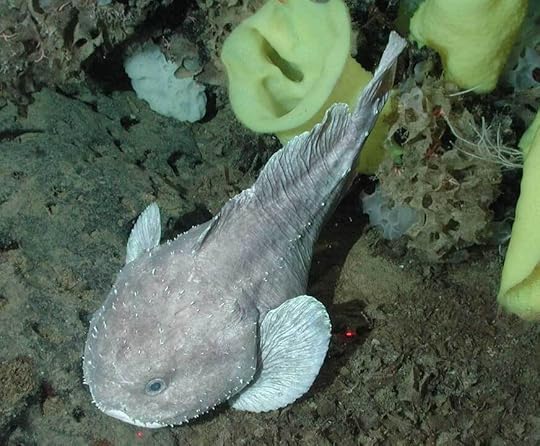
Photo Credits:
- Dead blobfish - Shahradraki, CC BY-SA 4.0, via Wikimedia Commons
- Live blobfish - NOAA/MBARI, Public domain, via Wikimedia Commons
Okay, let's dispel the big myth about the blobfish... that it looks like a blob with a huge nose. You may have seen viral photos like the one below:
 Yes, that really is a blobfish. But... that isn't what they look like when they are alive. Here's the real story: Blobfish live in really deep water, between 600 and 1,200 meters deep, where the pressure is at least 100 times greater than what you are now experiencing on the surface. When a blobfish is caught in a net and brought to the surface, the decompression causes its tissues to expand (killing it, obviously), and this distorts is features, particularly expanding its nose into a blob. Basically, it becomes a blob of goo, like a jellyfish washed up on a beach. Think of it this way... if I were caught and pushed down to 1,200 meters in the ocean, the pressure would make me look downright squishy and ugly too!
Yes, that really is a blobfish. But... that isn't what they look like when they are alive. Here's the real story: Blobfish live in really deep water, between 600 and 1,200 meters deep, where the pressure is at least 100 times greater than what you are now experiencing on the surface. When a blobfish is caught in a net and brought to the surface, the decompression causes its tissues to expand (killing it, obviously), and this distorts is features, particularly expanding its nose into a blob. Basically, it becomes a blob of goo, like a jellyfish washed up on a beach. Think of it this way... if I were caught and pushed down to 1,200 meters in the ocean, the pressure would make me look downright squishy and ugly too!Now, here is what a live blobfish actually looks like:

Photo Credits:
- Dead blobfish - Shahradraki, CC BY-SA 4.0, via Wikimedia Commons
- Live blobfish - NOAA/MBARI, Public domain, via Wikimedia Commons
Published on November 08, 2022 06:04
November 4, 2022
Awesome Animal Fact - Rare Softshell Turtle
Did you know the Yangtze giant softshell turtle is the largest freshwater turtle in the world... and is also the most endangered turtle?
There are about 30 species of softshell turtles, which are characterized by having a long neck and a flat, flexible shell. The Yangtze giant softshell, by far the largest, can weigh up to 546 pounds (247 kg).
The Yangtze giant softshell used to live in southeastern China and northern Vietnam. Unfortunately, the species has suffered habitat loss and overhunting to the point of being almost extinct. In fact, only three individuals are known to exist.
One of the three is a captive male turtle in China. A female was spotted in the wild in Vietnam, and In 2020 another individual was thought to be spotted in the same area. There could be a few more that haven't been found.
Can a turtle species with only three known individuals possible avoid extinction? Maybe. If scientists can capture a female, and get the female to mate with the only male in captivity, it's possible the female could lay several hundred eggs.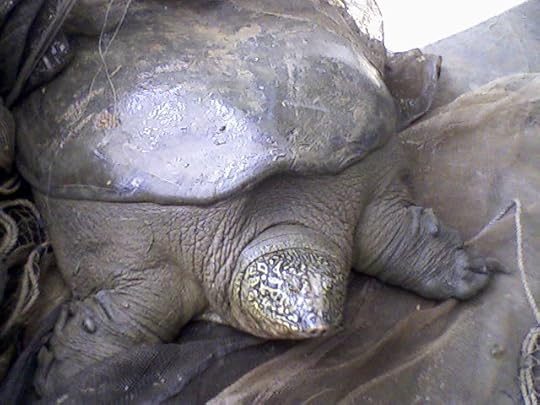
Photo Credits:
- Yangtze giant softshell turtle - Phuongcacanh at Vietnamese Wikipedia, CC BY-SA 3.0, via Wikimedia Commons
There are about 30 species of softshell turtles, which are characterized by having a long neck and a flat, flexible shell. The Yangtze giant softshell, by far the largest, can weigh up to 546 pounds (247 kg).
The Yangtze giant softshell used to live in southeastern China and northern Vietnam. Unfortunately, the species has suffered habitat loss and overhunting to the point of being almost extinct. In fact, only three individuals are known to exist.
One of the three is a captive male turtle in China. A female was spotted in the wild in Vietnam, and In 2020 another individual was thought to be spotted in the same area. There could be a few more that haven't been found.
Can a turtle species with only three known individuals possible avoid extinction? Maybe. If scientists can capture a female, and get the female to mate with the only male in captivity, it's possible the female could lay several hundred eggs.

Photo Credits:
- Yangtze giant softshell turtle - Phuongcacanh at Vietnamese Wikipedia, CC BY-SA 3.0, via Wikimedia Commons
Published on November 04, 2022 08:35
October 30, 2022
Awesome Animal Fact - Enlisted Bear
Did you know a Syrian brown bear named Wojtek was a corporal in the Polish military during World War II? How did such a thing happen? Well, in 1942 some polish soldiers, who were being evacuated from the Soviet Union, bought the bear as a cub at a railway station in Iran. They bought it from a young boy who had found the bear (the bear's mother had been killed by hunters).
At first, the bear had difficulty swallowing food, so the soldiers fed it condensed milk using a vodka bottle. They named the bear Wojtek (pronounced Voy-tek) and eventually started feeding it fruits and honey. Wojtek apparently had a fondness for beer, which the soldiers gave it as a reward. The soldiers grew fond of the bear, but they found it somewhat challenging to provide it with rations and to get permission to transport it. So, they officially enlisted the bear as a soldier, with the rank of private. Wojtek was listed among the soldiers of the 22nd Artillery Supply Company.
Wojtek was promoted to corporal due to his efforts during the Battle of Monte Cassino. As the story goes, Wojtek carried crates of ammunition by himself that normally required four men to carry.
After the war Wojtek spent the rest of his life at the Edinburgh Zoo.
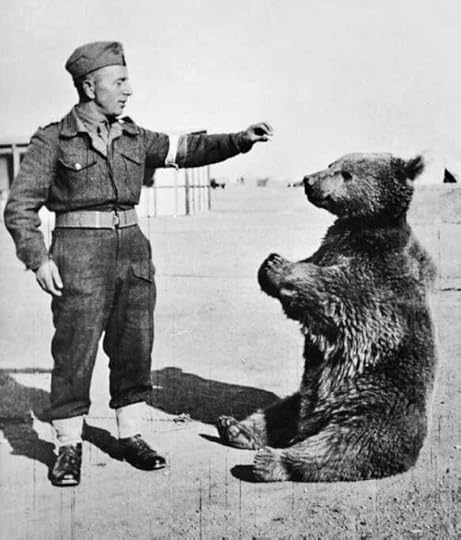
Photo Credits:
- Wojtek the bear - Imperial War Museum, Public domain, via Wikimedia Commons
At first, the bear had difficulty swallowing food, so the soldiers fed it condensed milk using a vodka bottle. They named the bear Wojtek (pronounced Voy-tek) and eventually started feeding it fruits and honey. Wojtek apparently had a fondness for beer, which the soldiers gave it as a reward. The soldiers grew fond of the bear, but they found it somewhat challenging to provide it with rations and to get permission to transport it. So, they officially enlisted the bear as a soldier, with the rank of private. Wojtek was listed among the soldiers of the 22nd Artillery Supply Company.
Wojtek was promoted to corporal due to his efforts during the Battle of Monte Cassino. As the story goes, Wojtek carried crates of ammunition by himself that normally required four men to carry.
After the war Wojtek spent the rest of his life at the Edinburgh Zoo.

Photo Credits:
- Wojtek the bear - Imperial War Museum, Public domain, via Wikimedia Commons
Published on October 30, 2022 18:36
October 27, 2022
Awesome Animal Fact - Thieving Pea Crab
Did you know the tiny pea crab spends its entire life inside a clam or oyster shell? The pea crab (Pinnotheres pisum), which is about the size of a pea, is considered a kleptoparasite because it steals food and oxygen from its host. As the oyster or clam filters food from the water, the pea crab steals a portion of the food. The crab also gets a safe home to live in.
Pea crabs often choose an oyster or clam as a host, but sometimes they live inside a sand dollar, in the tube of a parchment worm, or in the rectum of a sea cucumber. Sure, a sea cucumber's rectum doesn't sound like a desirable apartment, but the rent is affordable.
Interestingly, male pea crabs remain free-swimming their entire lives. It is the females that are kleptoparasites.
If you are eating seafood and find a pea crab inside one of your oysters, don't be grossed out. Pea crabs are considered a delicacy. Not only that, finding a pea crab in your oyster is considered good luck!
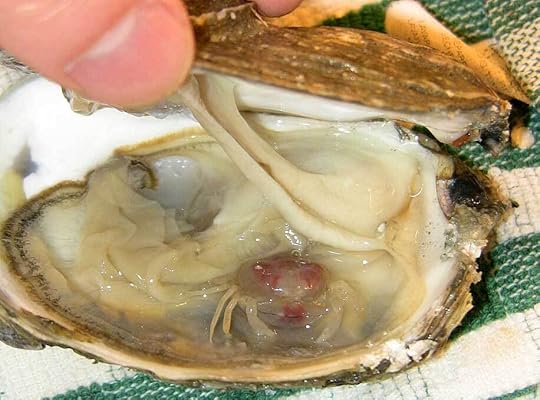
Photo Credits:
- Pea crab - Kikkiwikiwaki, CC BY 3.0, via Wikimedia Commons
Pea crabs often choose an oyster or clam as a host, but sometimes they live inside a sand dollar, in the tube of a parchment worm, or in the rectum of a sea cucumber. Sure, a sea cucumber's rectum doesn't sound like a desirable apartment, but the rent is affordable.
Interestingly, male pea crabs remain free-swimming their entire lives. It is the females that are kleptoparasites.
If you are eating seafood and find a pea crab inside one of your oysters, don't be grossed out. Pea crabs are considered a delicacy. Not only that, finding a pea crab in your oyster is considered good luck!

Photo Credits:
- Pea crab - Kikkiwikiwaki, CC BY 3.0, via Wikimedia Commons
Published on October 27, 2022 08:04



